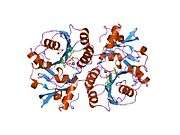B3GAT3
| View/Edit Human | View/Edit Mouse |
Galactosylgalactosylxylosylprotein 3-beta-glucuronosyltransferase 3 is an enzyme that in humans is encoded by the B3GAT3 gene.[3][4]
The protein encoded by this gene is a member of the glucuronyltransferase gene family, enzymes that exhibit strict acceptor specificity, recognizing nonreducing terminal sugars and their anomeric linkages. This gene product catalyzes the formation of the glycosaminoglycan-protein linkage by way of a glucuronyl transfer reaction in the final step of the biosynthesis of the linkage region of proteoglycans.[4]
References
- ↑ "Human PubMed Reference:".
- ↑ "Mouse PubMed Reference:".
- ↑ Kitagawa H, Tone Y, Tamura J, Neumann KW, Ogawa T, Oka S, Kawasaki T, Sugahara K (Apr 1998). "Molecular cloning and expression of glucuronyltransferase I involved in the biosynthesis of the glycosaminoglycan-protein linkage region of proteoglycans". J Biol Chem. 273 (12): 6615–8. doi:10.1074/jbc.273.12.6615. PMID 9506957.
- 1 2 "Entrez Gene: B3GAT3 beta-1,3-glucuronyltransferase 3 (glucuronosyltransferase I)".
Further reading
- Rual JF, Venkatesan K, Hao T, et al. (2005). "Towards a proteome-scale map of the human protein-protein interaction network.". Nature. 437 (7062): 1173–8. doi:10.1038/nature04209. PMID 16189514.
- Venkatesan N, Barré L, Benani A, et al. (2005). "Stimulation of proteoglycan synthesis by glucuronosyltransferase-I gene delivery: A strategy to promote cartilage repair". Proc. Natl. Acad. Sci. U.S.A. 101 (52): 18087–92. doi:10.1073/pnas.0404504102. PMC 535800
 . PMID 15601778.
. PMID 15601778. - Gulberti S, Lattard V, Fondeur M, et al. (2005). "Phosphorylation and sulfation of oligosaccharide substrates critically influence the activity of human beta1,4-galactosyltransferase 7 (GalT-I) and beta1,3-glucuronosyltransferase I (GlcAT-I) involved in the biosynthesis of the glycosaminoglycan-protein linkage region of proteoglycans". J. Biol. Chem. 280 (2): 1417–25. doi:10.1074/jbc.M411552200. PMID 15522873.
- Gerhard DS, Wagner L, Feingold EA, et al. (2004). "The Status, Quality, and Expansion of the NIH Full-Length cDNA Project: The Mammalian Gene Collection (MGC)". Genome Res. 14 (10B): 2121–7. doi:10.1101/gr.2596504. PMC 528928
 . PMID 15489334.
. PMID 15489334. - Gulberti S, Fournel-Gigleux S, Mulliert G, et al. (2003). "The functional glycosyltransferase signature sequence of the human beta 1,3-glucuronosyltransferase is a XDD motif". J. Biol. Chem. 278 (34): 32219–26. doi:10.1074/jbc.M207899200. PMID 12794088.
- Strausberg RL, Feingold EA, Grouse LH, et al. (2003). "Generation and initial analysis of more than 15,000 full-length human and mouse cDNA sequences". Proc. Natl. Acad. Sci. U.S.A. 99 (26): 16899–903. doi:10.1073/pnas.242603899. PMC 139241
 . PMID 12477932.
. PMID 12477932. - Kitagawa H, Taoka M, Tone Y, Sugahara K (2001). "Human glycosaminoglycan glucuronyltransferase I gene and a related processed pseudogene: genomic structure, chromosomal mapping and characterization". Biochem. J. 358 (Pt 3): 539–46. doi:10.1042/0264-6021:3580539. PMC 1222090
 . PMID 11535117.
. PMID 11535117. - Pedersen LC, Tsuchida K, Kitagawa H, et al. (2000). "Heparan/chondroitin sulfate biosynthesis. Structure and mechanism of human glucuronyltransferase I". J. Biol. Chem. 275 (44): 34580–5. doi:10.1074/jbc.M007399200. PMID 10946001.
- Ouzzine M, Gulberti S, Netter P, et al. (2000). "Structure/function of the human Ga1beta1,3-glucuronosyltransferase. Dimerization and functional activity are mediated by two crucial cysteine residues". J. Biol. Chem. 275 (36): 28254–60. doi:10.1074/jbc.M002182200. PMID 10842173.
- Tone Y, Kitagawa H, Imiya K, et al. (1999). "Characterization of recombinant human glucuronyltransferase I involved in the biosynthesis of the glycosaminoglycan-protein linkage region of proteoglycans". FEBS Lett. 459 (3): 415–20. doi:10.1016/S0014-5793(99)01287-9. PMID 10526176.
- Herman T, Horvitz HR (1999). "Three proteins involved in Caenorhabditis elegans vulval invagination are similar to components of a glycosylation pathway". Proc. Natl. Acad. Sci. U.S.A. 96 (3): 974–9. doi:10.1073/pnas.96.3.974. PMC 15335
 . PMID 9927678.
. PMID 9927678.
This article is issued from Wikipedia - version of the 11/26/2016. The text is available under the Creative Commons Attribution/Share Alike but additional terms may apply for the media files.




